
The DERIVE utility file MISC.MTH, allows you to evaluate left Riemann sums. The syntax is
LEFT_RIEMANN(function, variable, left endpoint, right endpoint, number of subdivisions).
The example given in the second picture below evaluates the left riemann sum for the function sin(t^2) for t from 2 to 3 with 500 subdivisions. The syntax is
LEFT_RIEMANN(sin(t^2), t, 2, 3, 500).
As modified by your instructor, the file MISC.MTH also allows you to evaluate right Riemann sums. The file supplied with DERIVE does not contain this command, though if you understand DERIVE moderately well and understand Riemann sums well, you could use the LEFT_RIEMANN command to actually get a right sum.
The INT command evaluates integrals. Its syntax is
INT(function, variable, left endpoint, right endpoint).
To evaluate the integral of sin(t^2) from t=2 to t=3, the syntax would be
INT(sin(t^2), t, 2, 3)..
If a function is strictly increasing, then the left sum will be less than the right sum, with the integral squeezed between them. Your text problems ask you to evaluate left- and right-hand Riemann sums for large numbers of subdivisions, and sometimes to compare the results with integrals.
"